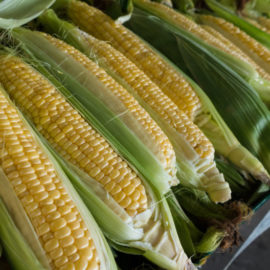
This is a free excerpt from one of Shortform’s Articles. We give you all the important information you need to know about current events and more.
Don't miss out on the whole story. Sign up for a free trial here .
If inflation is going down, why are food prices still rising? Will the prices ever go down? What’s causing grocery inflation?
Americans continue to feel the pain of rising grocery store prices, but food manufacturers appear unlikely to lower them—even as inflation cools and raw materials costs fall. Experts say that food prices will continue to rise through the end of 2023.
Below we’ll take a look at the causes of grocery inflation, and predictions for the future.
Food Prices Are Getting Out of Hand
Grocery store prices began rising at the start of the Covid-19 pandemic as processing facilities paused and slowed operations and labor, transportation, and raw materials costs increased. This led companies to pass along those cost increases to consumers.
In 2022, the Federal Reserve implemented a series of aggressive interest rate hikes to try to tame inflated prices. But critics warned that these efforts wouldn’t be enough to counter a significant driver of grocery inflation: Corporate pricing and profiteering strategies, which were slowing food sales, altering consumer buying habits, and worsening food insecurity.
In June, the White House’s Council of Economic Advisors (CEA) reported seeing signs of grocery inflation finally cooling, with drops in egg, fresh fruit, dairy, cereal, and baked goods prices driving grocery inflation down. But the CEA also noted that food prices remain considerably higher than before the pandemic—and that overall they’re still rising.
What’s Causing High Food Prices
Inflation, higher labor costs, elevated transportation costs, and supply chain issues have dogged food manufacturers and retailers since the start of the pandemic. In addition, experts say the following factors contribute to high and rising food prices:
- High production costs. These costs have increased in part because farmers have been paying higher fertilizer and animal feed prices and also because of packaging materials shortages. The USDA expects production costs to increase another 4.1% this year.
- Greedflation. Many companies continue to raise food prices higher than cost increases to pad their bottom line.
- Company efforts to offset sales volume declines. Some businesses have increased prices to compensate for consumers cutting back on their food spending—which many Americans have done in response to companies raising food prices.
- Bad weather. Wildfires and droughts in the western US led to lower crop yields, which has driven up food costs.
- The war in Ukraine. Ukraine, which before the war produced 12% and 9% of the world’s corn and wheat market, respectively, has been unable to export these goods at pre-war levels.
Looking Ahead
There’s broad agreement that food prices will continue to rise in 2023. The USDA predicts a 6.6% increase in prices for everything from poultry to dairy products, fats and oils, and cereal. Eggs, whose average price jumped 60% last December and remains 36% higher than in 2022, could see a price hike of anywhere from 5% to 33% between now and the end of the year, reflecting the product’s continued price volatility.
Though experts expect upcoming price increases to happen more slowly than in 2022—and say the cost of some items will even fall slightly, including for beef, pork and fresh fruits—some economists warn that once grocery store prices go up they tend not to return to their previous levels.

Want to fast-track your learning? With Shortform, you’ll gain insights you won't find anywhere else .
Here's what you’ll get when you sign up for Shortform :
- Complicated ideas explained in simple and concise ways
- Smart analysis that connects what you’re reading to other key concepts
- Writing with zero fluff because we know how important your time is






